Back in March of 2018, I wrote about my custom Fitz’ed Colt Official Police .38 Special here in these pages. Fellow RevolverGuys can tell from my story that I have more than just a passing interest in revolvers that have received the Fitz treatment.
Darryl Bolke wrote about Fitz-style revolvers here at RevolverGuy, in April of 2020, as well. For a more in-depth discussion of what made a real Fitz, a pseudo-Fitz, and a re-created Fitz, please refer to these previous presentations.
gunbroker Gold
In this piece, I’m going to share the story of my latest acquisition. It goes like this: Once upon a time, I was perusing Gunbroker—that online temptation site, that presents occasional deals, outrageously speculative prices, humdrum and common firearms, and, every once in a while, a really neat item that just strikes a person’s fancy.
I don’t go on Gunbroker often, unless I’m actually looking for a particular item. But, the way many things happen with the internet, I found myself going down that rabbit hole, and I was six degrees separated from my original search. This particular time, I wound up typing “Fitz” in the search box. This resulted in the usual one-page return of new, old-stock Fitz-brand grips, and newly-manufactured Fitz-Colt embroidered patches.
But on this occasion, one more item was displayed on the screen—a match for a Colt 1917 double action revolver. This wasn’t just any 1917 though, it was one that had been Fitz’ed at some time during its 102-year lifetime. According to the serial number gleaned from one of the photographs in the auction, this Colt was made in 1919.
WWI Necessity
The US Army Model 1917 was the military designation of two different revolvers—one made by Colt, and the other by Smith & Wesson. The Colt New Service (in .45 Colt) and the S&W Second Model .44 Hand Ejector were commercial production revolvers in 1917, when the USA entered WWI. While the Colt 1911 .45 ACP semi-automatic pistol was the official handgun of the US military, there weren’t enough of them to go around, despite the increase in production that came from contracting with other companies. As a result, the two US revolver manufacturers were asked to help out by converting their large caliber revolvers to handle rimless, .45 ACP semi-auto pistol ammunition.
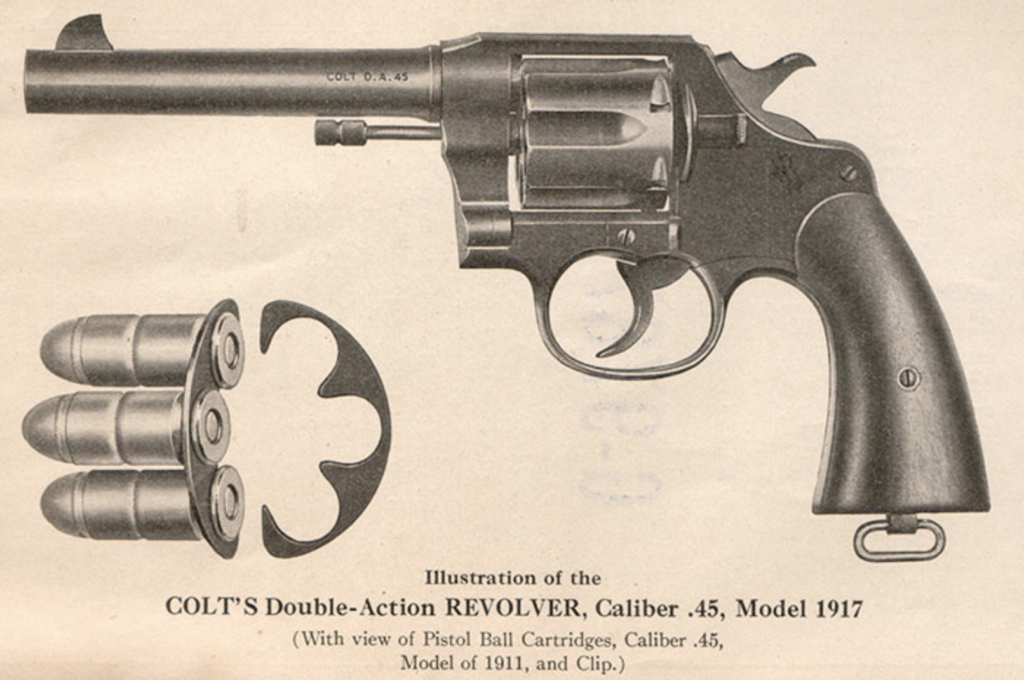
Smith & Wesson came up with half moon clips made of spring steel, that held three rounds each. Two of these in the cylinder filled all six chambers, and allowed a pump of the ejector rod to expend all six fired cases at the same time.
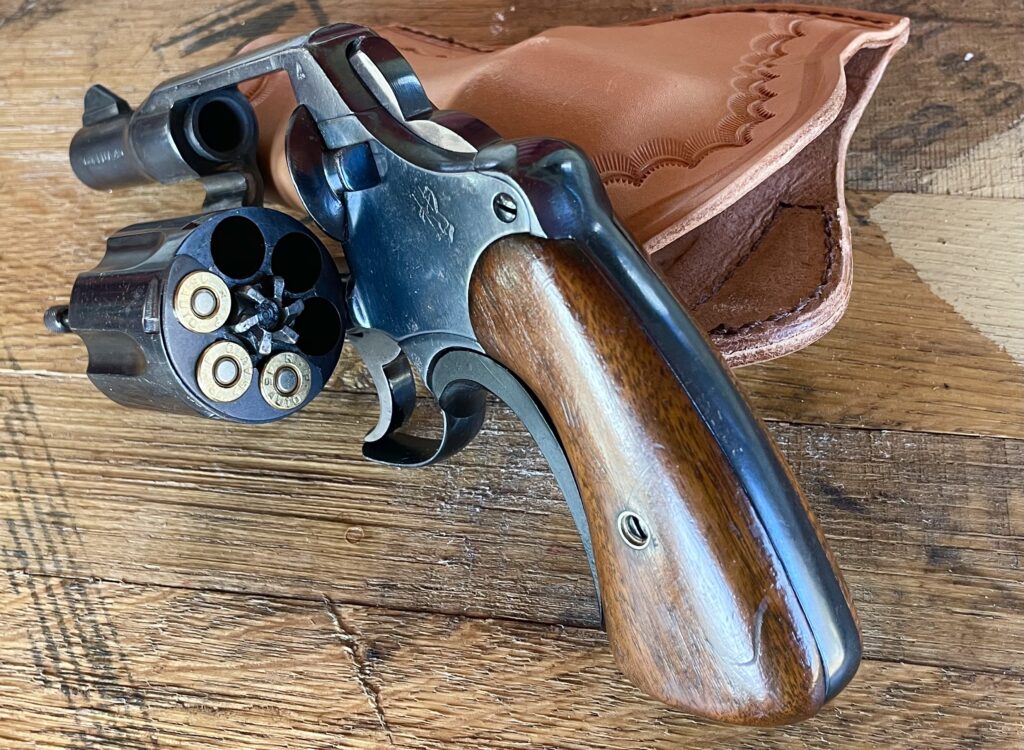
Lanyard rings were attached to the butts of the 1917 pistols and both had “United States Property” stamped under the barrel.
In more recent decades, Smith & Wesson has produced modern revolvers chambered for the .45 ACP pistol cartridge, and full moon clips allow all six cartridges to be loaded and ejected quickly in these guns. Full moon clips serve as speed loaders that stay in the cylinder, and reloading with them is very fast.
What About After the War?
Many of the military 1917s were mothballed, then resurrected for use again in WWII. When they came out of storage, they were refinished with a parkerized, matte gray/black/blue in place of their original, 1917-era, gorgeous polished blue.
Both the Colt and S&W 1917 revolvers had 5 1/2-inch long barrels. They were big revolvers, chambered in a defensive cartridge for which plenty of military surplus ammunition available—perfect for civilian use.
At some point, many of these 1917s made it out into the civilian market, with their old-world, handsome Colt blue still intact. This is how the one that popped up for auction during my accidental online search was finished. It’s easy to tell the difference between WWI use and WWII use due to the two different finishes.
Bidding on the Auction
This particular Colt 1917 already had its barrel professionally cut to 2 1/2-inches, and a new Colt front sight attached. The hammer was bobbed, to avoid snagging during a draw from a pocket, and the trigger guard’s front portion had been removed.

These were all typical features of the classic Fitz style, as performed by countless gunsmiths—both accomplished professionals, and basement/garage types. This revolver had its lanyard ring removed, the hole in the bottom of the grip was plugged, and the markings were removed there as well. The sharp corners on the bottom of the butt had been reduced to gentle curves, and the original walnut stocks (serial numbered inside to the gun) had also been re-contoured to match.

It appeared that the original bright blue finish was retained in the online photographs, although plenty of speckling and handling wear was obvious. The rampant Colt horse on the left side of the frame, and the Eagle-over-S20 ordnance acceptance mark both appeared sharp, and the screws looked “un-boogered.”
I considered the gun and clicked the “Watch” button. I kept coming back to it, as the auction wound down over the next several days. The description stated that it locked up tight and had a smooth action and good bore. The cost of a shooter-grade Colt 1917 would be around $800, and shipping it to a quality gunsmith—like Bobby Tyler at Tyler Gun Works—to have all of this custom work performed, would have likely tripled the cost.
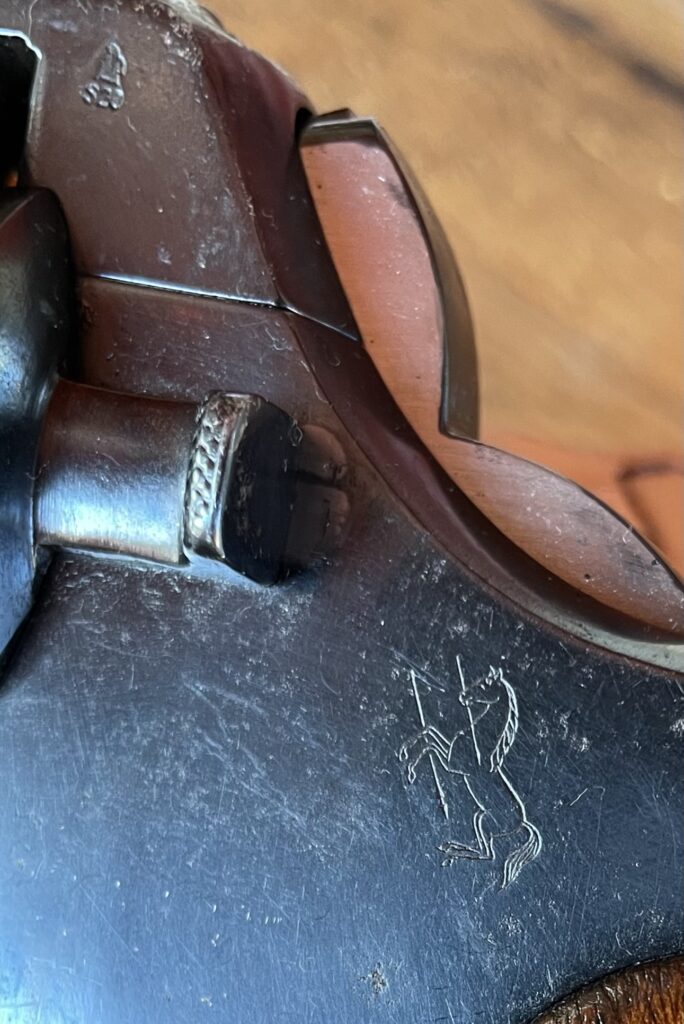
And it still wouldn’t be as cool as this one! When was the Fitz style work done on this 1917? Maybe in the 1930s or ‘40s? Maybe even the ‘50s? Who did the work? None of it really matters. To some, it’s a “ruined” gun, or its collector’s value has been “destroyed.” I didn’t want it for that reason, I wanted it because it just seemed really neat to me. I wanted to shoot it. On steel. Up close. From a holster. The way it was designed to be shot, with its Fitz attributes.
I Got It!
I waited until very near the auction’s end, and then I bid on this big bore snubby and won it. When it arrived at my local, small shop FFL, he was a bit confused as to what I had bought . . . and why. I tried to explain it to him. He’s a relatively new gun guy (some would say gun culture 2.0) and he didn’t know the history of John H. Fitzgerald. When he asked, I enlightened him. I think he felt like Groucho Marx, as I went on and on with my answer, and perhaps he wanted to shout, “I withdraw the question!”
Newly-acquired guns, no matter if they’re new from the manufacturer, or old used guns that are new to you, should be throughly cleaned and oiled before shooting. Upon inspection, I realized I got a really good deal on a real sweet old Colt. The gun functioned perfectly and the action was as good as the day it left the Colt factory. The finish was original, except for where the gun had been cut on the hammer, the trigger guard, the bottom of the grip, and the barrel. All of these spots had been re-blued and the job was done well.
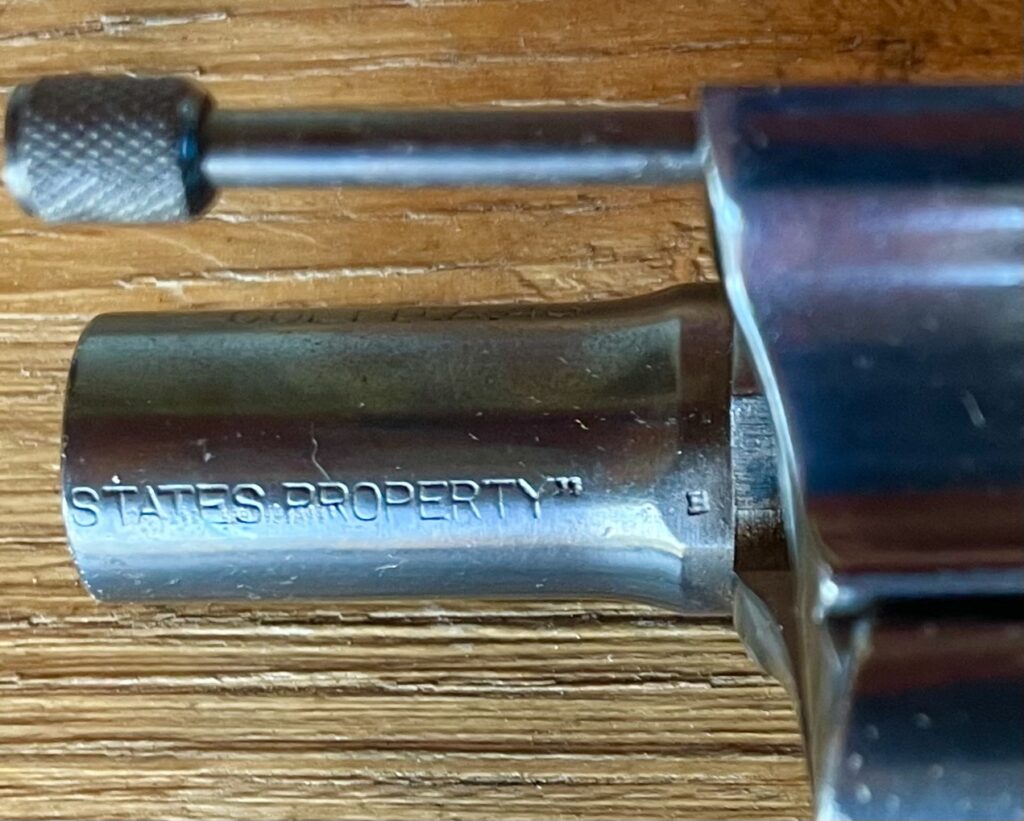
While the left side of the barrel retained the Colt D.A. 45 marking, the front sight had been placed over the remaining patent date writing on top of the barrel, and the underside stamping now only read, “STATES PROPERTY.”
My big hands just do not fit the factory grip, and the idea of shooting 230 grain factory ball ammo out of this snubby with that grip profile made my hand hurt, before I even let a single round go downrange.
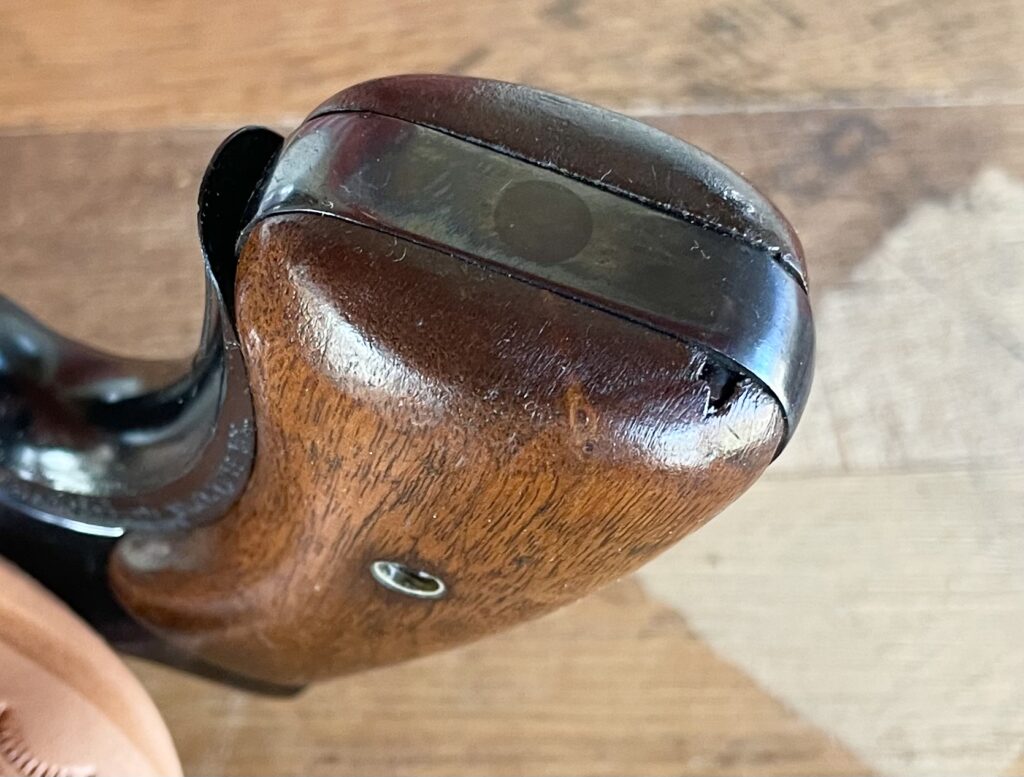
Replacing the old walnut stocks with custom oversize grips would be a crime. The answer was a grip adapter—either an old Tyler T-Grip (no relation to Bobby Tyler), or an even older Mershon (later Pachmayr) “Sure Grip” out of Glendale, California. I found one of these for sale on eBay. It fills the grip perfectly and matches the style of this revolver well, while retaining the uniquely rounded wood stocks (which may be just slightly shortened as well, since the bottom of the right grip is missing a tiny bit of wood where the locating pin can be seen—this may be a result of polishing out the bottom of the grip to remove the markings).
Gotta Have a Holster
While Fitz style revolvers were most often carried in big suit or coat pockets, back in the day, a holster is how I wanted to carry this 1917.
I go on daily walks here on our property in Tennessee. The only real danger is of the slithering kind, and I’m currently up to seven venomous snakes that I’ve needed to dispatch. Cottonmouths and copperheads have reared their triangular shaped heads too close to the cabin and our dog, and while the two varieties of rattlesnakes (at least they would give us a noisy warning) have yet to be seen during the almost three years since we purchased our home, we know they’re close by. CCI shot shells in .38 and .44 caliber have worked well, and now I need to find some .45 ACP versions for the new Fitz.
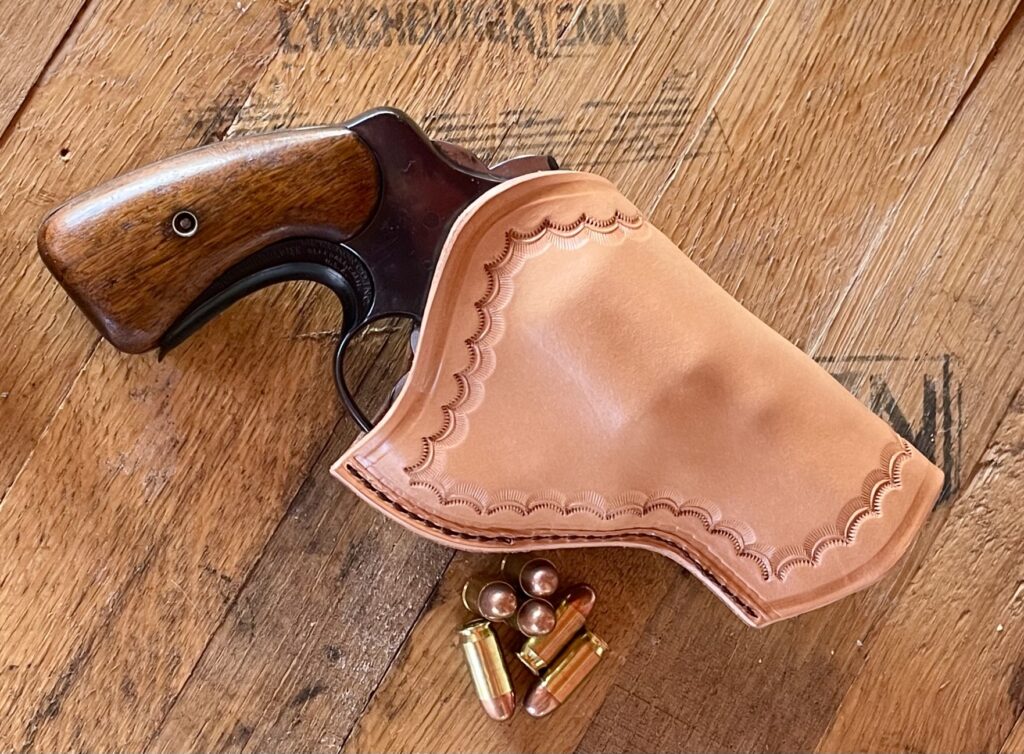
Rob Leahy at Simply Rugged Holsters is not only a super nice guy, he is also very knowledgeable when it comes to firearms. He knows all about vintage revolvers and pretty much everything else. His company offers many different styles of leather holsters for every type of firearm carry anyone would ever want. From concealment, to field carry, to hunting, Rob has you and your gun covered. His specialty arose from necessity, in that he created field holsters that protect the gun’s finish, with high sides that flare outward for quick and easy re-holstering.
I contacted Rob and asked him which of his offerings would be best suited for my 2 1/2-inch barreled Colt. He replied that his Eldorado would work well. I ordered through his website and chose a tan, right-hand draw Eldorado with just a little bit of extra fanciness. I requested border stamping around the edges to add a little style, worthy of this Colt’s personality.
When the holster arrived, it fit perfectly (keep in mind that the Colt 1917 was never made in this barrel length at the factory). The holster is molded to the revolver’s shape and it sort of “snaps” in and out, deleting any need for a retaining strap or thong to keep the gun in place.
Let’s Go Shoot!
Drawing a Fitz’ed revolver from a holster provides the shooter who is paying attention to such things with the reward of a speedier first shot on target. Fitzgerald had huge hands and fingers and getting his index finger deep on the double action trigger was made easier with the trigger guard cut away. This also provided easy access while wearing winter gloves. While we’re only talking about the smallest improvement in timed draw, I can still tell that I can get that first shot off quicker because my finger goes to the trigger faster when the handgun clears leather.
The front sight on this Colt is too high and I may take a big file and carefully shave it down, then touch up the blue. I shot a steel silhouette at five yards. That’s pretty close, and this .45 shoots way low at that “up close and personal,” Fitz-style distance. If I aim at the chest, I get hits in the groin at that distance. To correct that, I just pull the trigger when the front sight is sticking up in the middle of the rear fixed sight channel around an eighth of an inch. This works to get shots where they need to go. I’m not an advocate of point shooting (not using the sights at all), so using the sights to get a flash sight picture like this works well at such a close distance.
The Colt’s double action pull is long, and not easily staged like a S&W’s trigger pull. This Colt needs to have its trigger pulled quickly, consistently, and straight through, while maintaining the sight picture. Hits in a tight group were easily accomplished after a couple cylinders of practice to become accustomed to the revolver’s traits and personality.
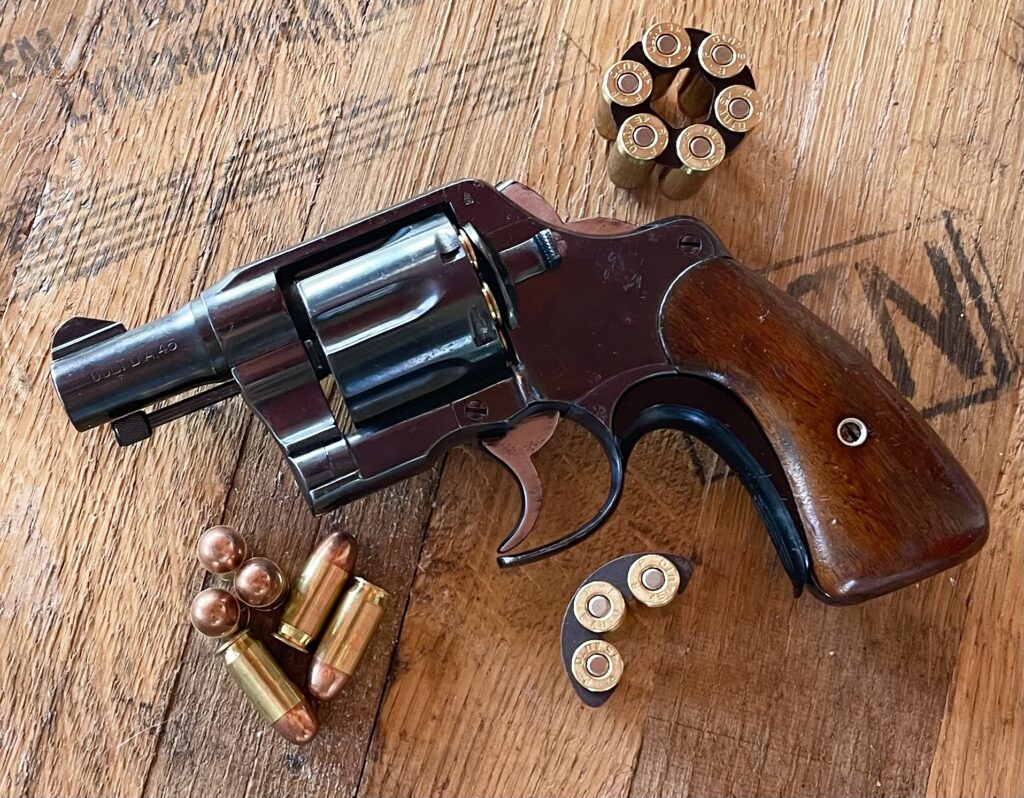
Recoil with 230 grain ball ammo, basically the same stuff used in WWI and WWII, is certainly not light in this big gun. It’s not a .44 Magnum, but it’s subjectively equivalent, in my opinion, to shooting full-house 158 grain .357 Magnums out of a 4-inch barreled revolver. The muzzle doesn’t rise much, and there’s some flame, from ejected powder that’s still burning, when you shoot. The gun pushes back into your palm, more than the muzzle rises.
After around thirty fired rounds, the inside of my shooting hand’s thumb started to throb from riding up alongside the edge of the grip’s hump, under the hammer. The last twelve rounds out of a fifty round box of factory ammo actually hurt. I was done at that point.
During another shooting session, I concentrated on keeping a firm grip that was low on the wood stocks, and gave my trigger finger straight back movement. This grip stopped the edge at the top of the grip panel from hurting my thumb again, but I had to readjust my grip after each shot, as recoil moved it in my palm, due to the lack of traction from the smooth wood stocks.
Lighter weight, 185 grain hollow points had less perceived recoil, and Liberty Civil Defense 78 grain cartridges seemed to have the least amount of recoil. My hands sure liked shooting them much better than the ball ammo.
The .45 ACP cartridges can be loaded in the cylinder chambers just like rimmed revolver cartridges. This Colt will fire them because the chambers are shouldered, and this keeps the rimless cases from falling through the cylinder. Apparently, some early 1917 Colts did not have this feature, and those guns must use moon clips to headspace the cartridges.
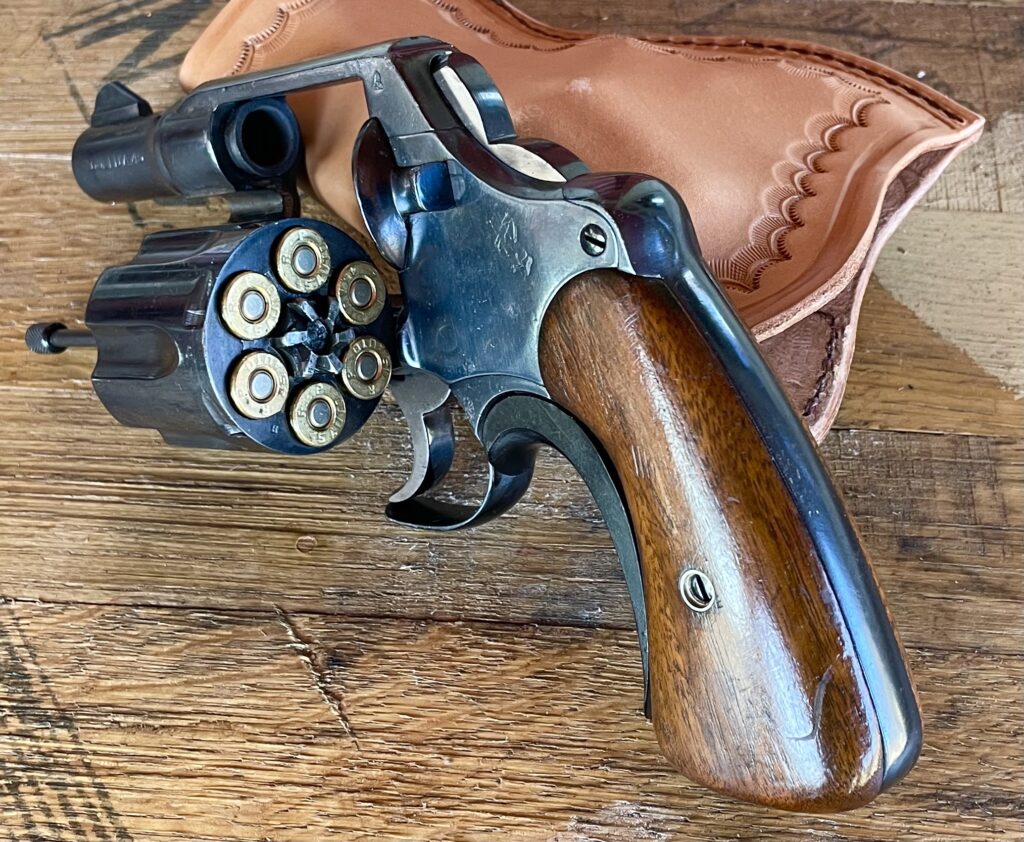
I found that the fired cases either fell out from gravity when the gun was held upside down, or could easily be plucked out with my fingernails. If any got stuck, a pencil/pen/small screwdriver could be used to punch them out from the front of the cylinder face.
I bought full moon clips, but found that some of them were slightly too thick for the cylinder to close, or they bound the rotating cylinder when I pulled the trigger. Some online research appears to indicate that full moon clips work great in S&W revolvers chambered for the .45 ACP cartridge (including the 1917, the 1937 Brazilian contract 1917s, and modern S&Ws), but they’re just not a good fit for the Colts. Oddly, one full moon clip worked fine. Maybe it’s just microscopically thinner? My dad had a “box o’ gun parts” that I still have, and inside was one half moon clip. I tried it and it worked fine. Finding original half moon clips is not easy however.
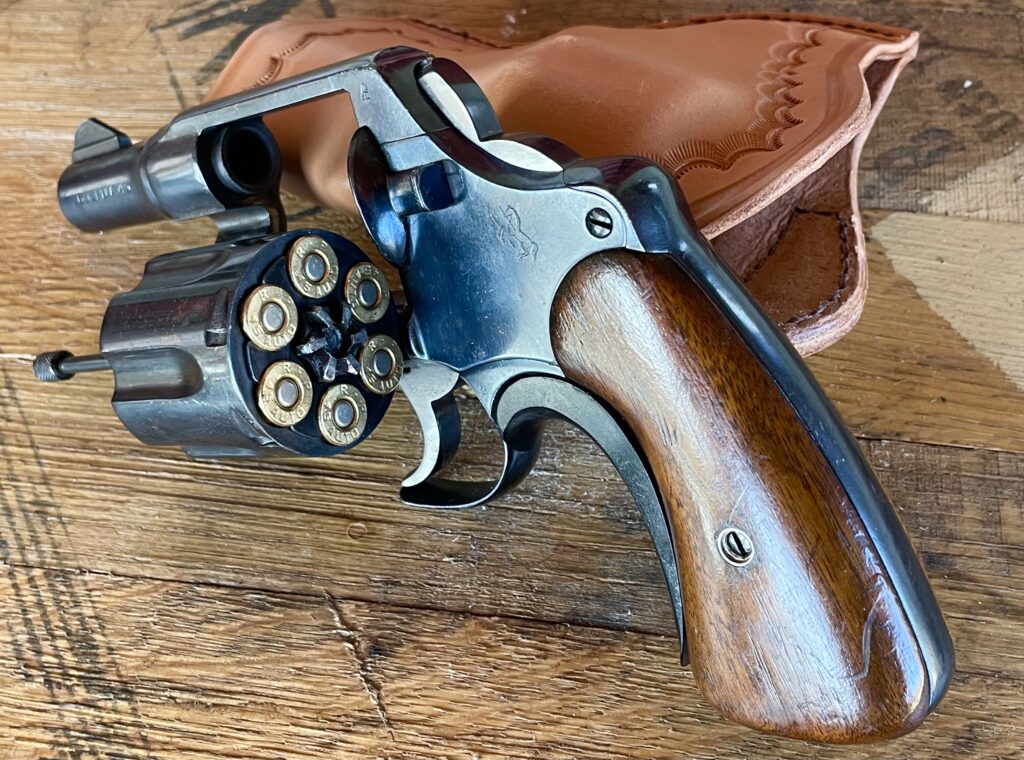
I also purchased a knurled, blued steel device for unloading the fired cases from the full moon clips, without bending the clips. Made by Innovative Industries, the Moon Clip Extraction Tool sells for only ten bucks. It works extremely well, and I used to use it when I had a S&W 1937 Brazilian contract 1917 .45 ACP revolver, but I sold it when I sold the revolver.
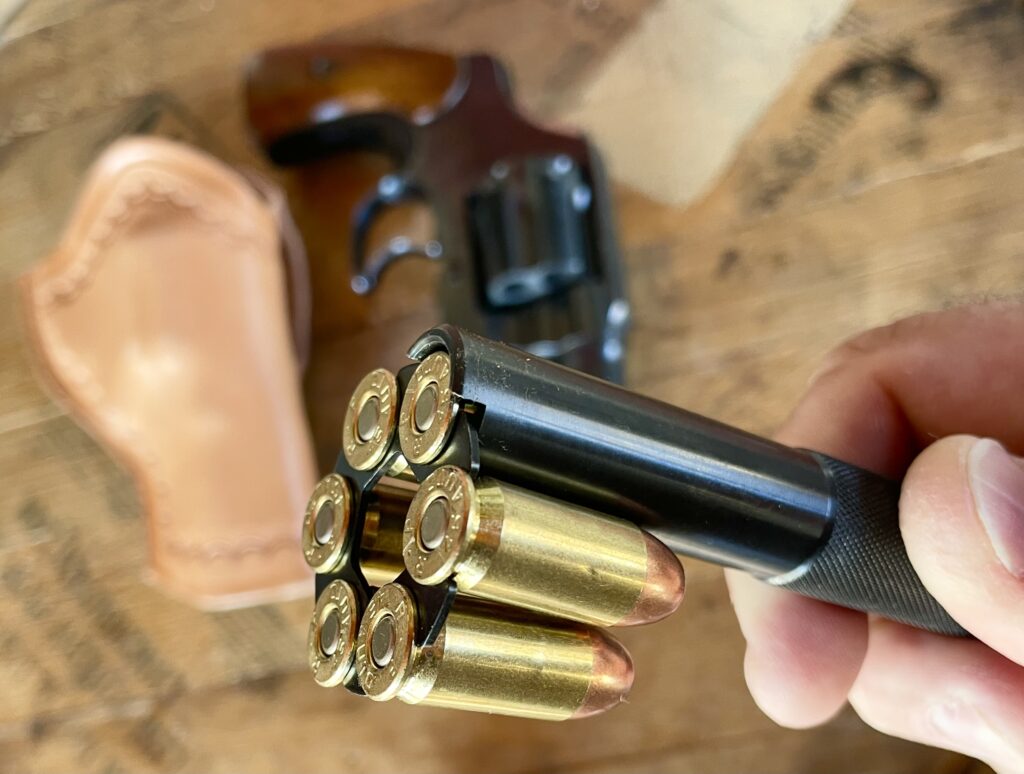
Honest Use
Of course, this is not a gun that will be carried for actual self defense—although it would work quite well in that regard, I would think. For me it’s a range gun, a piece of history, and a snake killer. That’s its honest use today. It was likely Fitz’ed back in the ‘30s or ‘40s for someone who actually carried it in a pocket for self protection—maybe a police officer, who wanted something more powerful than the .38 he was issued? Perhaps a gumshoe private eye, right out of a Mickey Spillane novel?
This Colt 1917 .45 makes me happy, and makes me smile, and I think that’s the best use for it, of all!

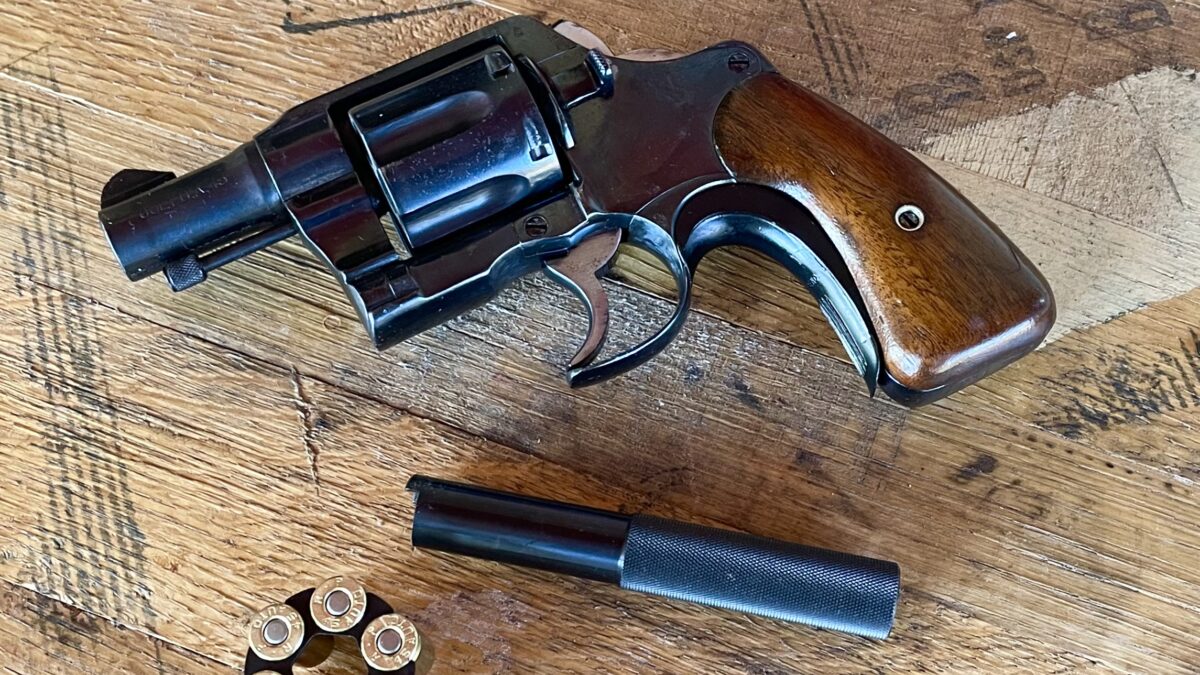
That’s a nice find! I have a love (actually more of a fetish) for .45 ACP revolvers, especially 1917s, but my only experience is with the Smiths, and this is the first I’ve heard of the full-moon clip problem with Colts. Thank you for expanding my knowledge yet again.
When I was a young whippersnapper (not that I’m not one now), the old Stoeger “Shooter’s Bible” had .45 ACP Smith revolvers that appeared identical to the 1917s, but without the lanyard loop in the butt, that were marked “Model of 1950.” I’ve never read anything about them, even though info on the Model 1955 Target, a nearly identical gun with adjustable sights and an underlug barrel to protect the ejector rod, is pretty easy to find. Know anything about them?
I’m personally not a fan of the cut-off trigger guard, but a Fitz-ed revolver that’s done right, whoever did it, is a piece of history. If you ever decide yours needs a good home . . . (Yes, I’m a giver.)
Those Smith 50s and 55s are great guns too!!
Glad you liked the article and that you like 1917s and .45 ACP revolvers.
I never should have sold my 1937 Brazilian contract S&W!
Steve, what an amazing looking Colt Fitz special! I currently have an old 1895 Colt DA .38 that worked a few days ago and after i removed the side plate to inspect for gunk etc, once carefully reassembled the revolver is getting stuck during the trigger pull. This revolver was passed down from my wifes grandfather and she wants to convert it to an old Fitz. Greetings from Crossville, TN.
Hello. I have a Colt New Army model 1892 and I think I might know what the problem is. I had that problem when I removed the side plate before, and fixed it by moving the hand spring to the right a bit (as if you’re looking at it from the back). Move it towards you. It’s likely binding up on a projection of the side plate. Especially if it works with the side plate removed. Hopefully this helps. I know this is late, as I just happened to stumble upon this site. So you might have fixed it already. But if not, and you still have it, hopefully this can fix your problem. Have a good one!
-Brian
Brian, I appreciate you writing in to help Aston, and whoever else might see it! Welcome aboard!
Steve, we’ve seen some neat guns here on RevolverGuy, but this one REALLY exudes old-school cool! Thank you for sharing this awesome Fitz with us! You should be proud of that one.
Thanks Mike! The world of revolvers is expansive and historic. More to come!
Now that’s a gun! Congratulations and thanks for a fantastic write up.
Steve. Thank you for the article on the Fitz. Really enjoyed your, as always, excellent images. I too am fascinated by all the things gun handlers through the years have come up with to improve their use of hand guns.
Hope you are enjoying your well deserved retirement and your relocation. If you travel west into the Ozarks coffee is on me.
Tony
Thanks Tony! I appreciate your compliment on the photos. My high school photography teacher would be smiling! I am really enjoying Tennessee and the shooting here is really great! I’ll let you know if I get to the Ozarks!
Say, that’s swell! I’m not a huge Fitz guy or anything but I can appreciate unique things, certainly. I wonder if you might be able to sand down a moon clip until it was thin enough to use? If it can be done on sights, why not other things?
I thought the same thing about sanding down a full moon clip to see if it will fit better. I think its the cutout in the center that isn’t working in concert with the Colt ejection star. It may have been made using a S&W’s system and the maker (no idea who it is) didn’t try it on a Colt. It seems like maybe a little Dremel work to open up the inside polygon might work. Hmmmmmmm.
Really enjoyed this read. I have one of the Brazilian re-imports and I’d sure like to shorten the barrel but leave the grip and hammer intact. Thanks for writing about this one.
John, I had one of those 1937 Brazilian contract revolvers too. Really great guns!
Back in “the old days” that Fitz’ed Colt Model 1917 .45 ACP was a very potent snub nose. Heck, it still is today–I’d feel well armed if I were carrying that piece.
I agree with you 100% Spencer! Even with 230 grain hardball, it’s potent! No hollow points needed!
Interesting revolver and article! Looks like the gunsmith did a great job installing the front sight and rounding off the butt contours. The state of the seams on the sideplate indicate that it was almost certainly reblued–they’re too rounded off for stock. Fortunately, as you note, whoever did the work kept the rampant colt intact. The trigger originally would have been blued, too. But on an obviously custom revolver like this, none of that matters anyway. A distinctive piece of revolver history–very cool.
Steve H, very good take on the trigger having polished sides. Looking at pictures of other 1917 Colts, I think you’re right!
Wow – a fantastic piece of history and another great article. Love that Simply Rugged holster, and I’m glad to see you kept the walnut grips – they really belong on that gun. Thanks for sharing!
Thanks Hammer! Rob at Simply Rugged makes great holsters! I’m glad I kept the walnut stocks, but I don’t know what I would have replaced them with anyway since the grip frame was custom rounded. I’m lucky these survived all these years!
Mr. Tracy, reading about your 1917 Fitz made me happy too. Thank you for sharing this excellent find with us!
I love my “ruined” M1917 Colt, too. It is not a Fitz, but it was chromed at some point. Colt-Purists sniff but it is a great shooter. It handles 230gr hardball fine, but the
Barrel was not cut 🙂
Thank you for your story as well as educating Gun Culture 2.0 on the Fitz.
Thanks Bill Shailer! Glad you enjoyed it!
About 25 years ago a lady from our local small town bank called me. She said she’d found an old gun in some nook at the bank. It was wrapped in an old canvas bank bag and asked me to come look at it. I checked it out to find a Smith 1917 in mint condition. She said she didn’t know what to do with it and asked me if I was interested in buying it. ABSOLUTELY! She asked me what I would give for it and I told her $200. She added that she just wanted it out of the building and it was mine if I wanted it. SOLD! I took it to the PD and showed it to our City Clerk. She said that her grandfather was president of that bank in the 40’s and she was sure that it was his. As she and her husband were my friends, I let her have it for the $200 bucks I paid for it. Fitz Special is a cool gun as is the article. Thanks!
That’s a cool story, Jack! You’re a good man to reunite it with its family!
Just happened on this site subsequent to perusing a 2020 Handgunner magazine article with a Milt Sparks carved holster to fit a 1917 Colt. I purchased a 1917 Colt from a deceased gunsmith who bought it from the estate of the last Marine commanding officer at Portsmouth Naval prison in Maine. Unfortunately I don’t have any correspondence attributing it to him for provenance.:-( Shooting 230 gr cast bullets was a pleasure. It did shoot a little off the bull but remembering and article by the late Skeeter Skelton about how to adjust fixed sight revolvers, I twisted the barrel (in or out I can’t remember)slightly and now she shoots dead on at 50′. Fist sized groups centered perfectly.
WRT snake protection, long before commercially available pistol shotshells I bought a set of dies for .45 acp shotshells and worked up a load that would cycle a 1911. I don’t live where there are snakes but were I that might become my Woodswalker!
Oh and by the way, my 1917 is a 1919 issue and is Parkerized with lanyard hole filled.
Welcome aboard, Ralph! Glad to have you here. Pull up a chair and stay a while.
I as welll have a fitz special no cutout trigger but the guard is cut inward to alllow a faster trigger acquisition . For a righ t hand shooter ,The barrel ends just at the ejector rod .
Mine will chamber 45 colt and use moon clips with 45 acp just fine . I do carry it in a shoulder rig for self protection and woods walking . I’d like to send a photo . Good article not much about fitz specials .
Lloyd
Thanks Lloyd! Be sure to check out the other Fitz article from Steve, about his Fitz’d Official Police:
My Fitz Colt Official Police
Hello, I received a colt 1917, a few years ago, that was in a box, apart to the bare frame! All the parts were there, except a unbroken bolt!
I ordered and received another one, and learned that I have a bit to learn about these colts, vs Smiths!
Timing is off!
I am going to try it again, if I can’t find someone who knows how to, and is willing to work on it!
Any information would be appreciated!
Robert, the list of good Colt ‘smiths is short, these days. I’d consider reaching out to friends Bobby Tyler at Tyler Gun Works, or Milt Morrison, at QPR Precision Gunsmithing, as a start.
As you’ve discovered, the old Colts are not a DIY project. It takes someone who really understands these guns to repair them.